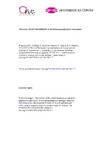Efficient Multiscale Representations for Geographical Objects

View/
Use this link to cite
http://hdl.handle.net/2183/40443Collections
- Investigación (FIC) [1723]
Metadata
Show full item recordTitle
Efficient Multiscale Representations for Geographical ObjectsAuthor(s)
Date
2022-05-19Citation
Brisaboa, N.R., Cortiñas, A., Gutiérrez-Asorey, P., Luaces, M.R., Rodeiro, T.V. (2022). Efficient Multiscale Representations for Geographical Objects. In: Karimipour, F., Storandt, S. (eds) Web and Wireless Geographical Information Systems. W2GIS 2022. Lecture Notes in Computer Science, vol 13238. Springer, Cham. https://doi.org/10.1007/978-3-031-06245-2_7
Abstract
[Abstract]: Maps need different representations of the same cartographic object in order to display it at several scale levels. When a user zooms in, the object should depict every detail as it is the main focus on the map. On the contrary, when the user zooms out, there is no need to display every single detail of the object as most would become as small as to be invisible. A common technique to speed up the display process is storing several representations for the same object at different scales. However, this technique raises redundancy, and therefore it increases space usage. This work aims at suppressing that redundancy by introducing four alternatives that use a unique representation for each cartographic object while still being able to retrieve simplified versions of them depending on the requested scale.
Keywords
Cartographic generalization
Compression
Geographical information systems
Compression
Geographical information systems
Description
The congress was held in Constance, Germany, April 28–29
Editor version
Rights
© 2022 Springer Nature Switzerland AG
ISSN
1611-3349
0302-9743
0302-9743
ISBN
978-3-031-06244-5 978-3-031-06245-2





